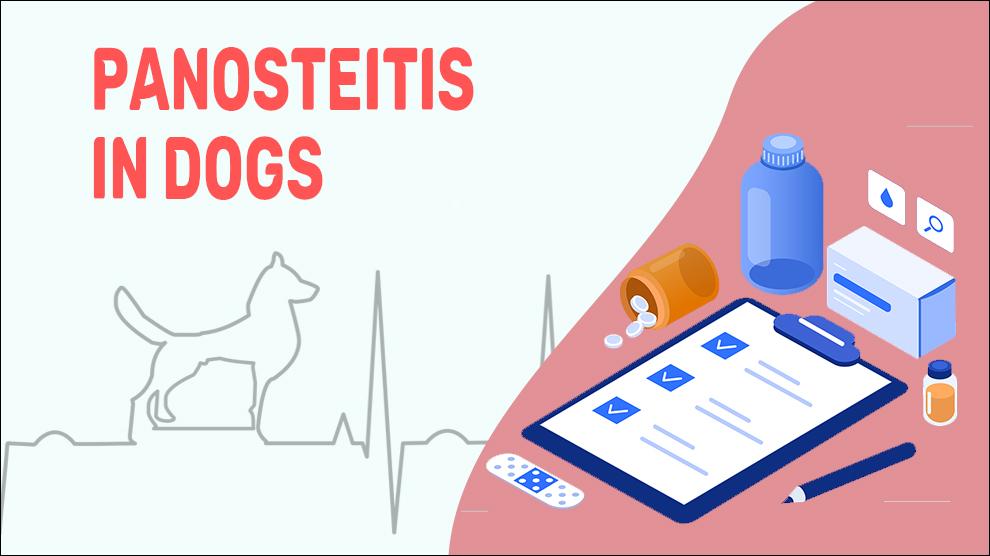What Is Panosteitis In Dogs?
Panosteitis (AKA Pano) is an inflammatory, mostly idiopathic, orthopedic condition in which the external layer of the bone known as the periosteum becomes inflamed painfully. Panosteitis typically affects the long bones, but it can also affect the hocks (ankles), hips, and knees.
This is also called ‘growing pains’, Eopan, Eosinophilic panosteitis, Enostosis, and Endosteal proliferation of new bone. Large breed dogs between the ages of 6-18 months are most likely affected, though the official range is the first three years of growth. Interestingly, this is prevalent among male dogs, comprising >60% of all cases. In the case of female dogs, the onset of this disease is mostly linked with their first heat.
While the cause of the condition remains unidentified, experts consider that genetic factors, mineral over-supplementation (through the diet), excessive protein consumption, and infections play a role. In particular, high calcium intake is associated with this disease.
The bone marrow fills up with a type of fibrous tissue with several osteocytes and irregular bundles of collagen fibers called ‘woven bone’. Fortunately, the marrow’s ability to produce blood cells is not affected by this unusual development. Ultimately, the woven bone gets replaced with normal bone wherever required, disbanding any woven bone remaining in the marrow.
Panosteitis is described as largely idiopathic, as it is not caused by any existing disease. Although the condition is usually self-limiting and benign, it is always good to get the opinion of a veterinary neurologist. There are no reported behavioral or neurological problems.
Symptoms Of Panosteitis In Dogs
- Limping
- Pain upon palpation of limb
- Deformed bones
- Rigidity/ Stiffness
- Trouble getting up
- Swelling/Inflammation of joints
- Weight gain
- Excessive panting
Treatment Options For Panosteitis In Dogs
For Mild cases:
Physical therapy, chondroprotective agents, and making sure the affected dogs do not become overweight are enough.
NSAIDs like
- Carprofen (Rimadyl, Canidryl, Rimifin, Vetprofen)
- Meloxicam (Metacam, Muvera, Mobic)
- Firocoxib (Previcox, Equioxx)
- Deracoxib (Novartis)
- Etodolac (EtoGesic, Lodine)
Pain-relieving medications like amantadine, tramadol, gabapentin, etc may be prescribed by veterinarians.
Joint supplements: chondroitin/ Glucosamine (e.g., Cosequin, Dasuquin, Glycoflex, Vetri-Flex) and essential fatty acid supplements.
Home Remedies For Panosteitis In Dogs
- Ensure the protein and calcium in the dog diet is not more than the required quantities.
- Increase exercise options for the dog such as playing with other dogs, going for a run or hike, Chasing a ball or Frisbee, etc.
- Weight management for your dog is important.
Prevention Of Panosteitis In Dogs
Pano etiology is not yet understood completely. The pets’ prognosis for healing will depend on the findings made by a veterinarian. There’s not much a pet owner can do to prevent them as Hereditary is a factor in some breeds but a high-quality diet with bone supplements may help somehow or other.
Affected Dog Breeds Of Panosteitis
Afghan Hound, Akita, American Cocker Spaniel, Basset Hound, Bernese Mountain Dog, Boxer, Bull Terrier, Chesapeake Bay Retriever, Chow Chow, Shar Pei, Dalmatian, Doberman Pinscher, English Setter, English Springer Spaniel, Great Pyrenees, German Shepherd, German Shorthaired Pointer, Golden Retriever, Great Dane, Irish Wolfhound, Labrador Retriever, Mastiff, Newfoundland, Rhodesian Ridgebacks Bulldog, Rottweiler, Saint Bernard, Shih Tzu, Weimaraner, Medium Breed Dogs, Large Breed Dogs
Additional Facts For Panosteitis In Dogs
1. Cause:
- Genetic factors
- Autoimmune components
- High-protein, high-calcium diet
- Stimulation of pain receptors in the soft tissue lining of the diseased bone
- Rapid growth
- Infection
- Stress
- Lesions
- Change in bone density
2. Types:
- Eosinophilic panosteitis (inflammatory)
- Juvenile osteomyelitis (inflammation of bone)
- Enostosis (bone lesion)
3. Mortality:
There is no evidence of Pano alone affecting the life span of dogs.
4. Diagnosis:
- Bloodwork to check for hormonal conditions
- Radiographs to look at the bones and joints
- Orthopedic exam to check for joint pain or problems
- Magnetic resonance imaging (MRI)
- Arthrograms
5. Prognosis:
Pano is not a progressive disease and it eventually goes away with time (within 18-24 months of age). Veterinary intervention is usually necessary only when the dogs could not tolerate the pain.
When To See A Vet For Panosteitis In Dogs?
Contact your vet right away, if you notice:
- Limping
- Lameness starts in one limb and progresses to all four
- Deformed bones
Food Suggestions For Panosteitis In Dogs
- Raw meaty bones, raw chicken wings, or lamb flaps.
- Protein- Lean chicken or turkey breast, lean beef, and Cooked fish (salmon, tuna).
- Plant-based protein sources – Buckwheat, Chickpeas, Lentils, green peas, Oats, and Seeds.
- Dark-green, leafy vegetables like spinach, broccoli, and watercress.
- Omega 3 fatty acid foods (salmon, Sardines, Mackerel, Herring, etc).
- Antioxidants – Blackberries, blueberries, Cauliflower, Beets, Beans, etc.
- Grains: Oatmeal, Barley, Brown rice.
Conclusion
Panosteitis in dogs is a non-progressive, self-limiting disease that affects the animal’s bones and can restrict a dog’s mobility in its growing stages.
For a condition like Pano, Most of the treatments are planned to treat the pain and delay the progression. So apart from treatment, discuss with a veterinarian any home care specific to your dog’s situation.

















